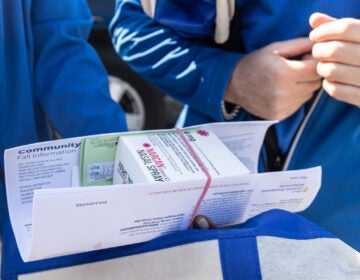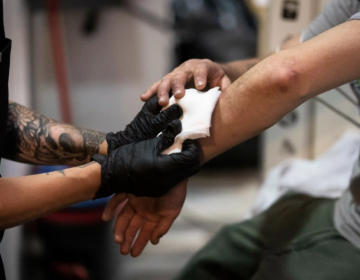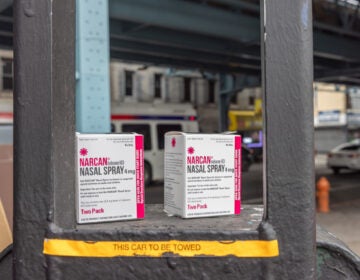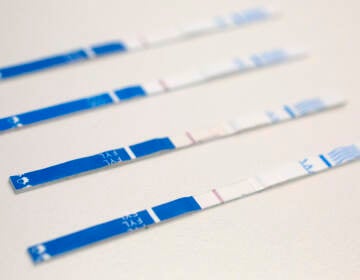Philadelphia drug overdose deaths fall, but novel substances in the street drug supplies present new dangers
Medetomidine, a nonopioid veterinary sedative, could be overtaking xylazine in the street drug supply. The drug was found in 72% of street samples from Philly last year.
Listen 1:15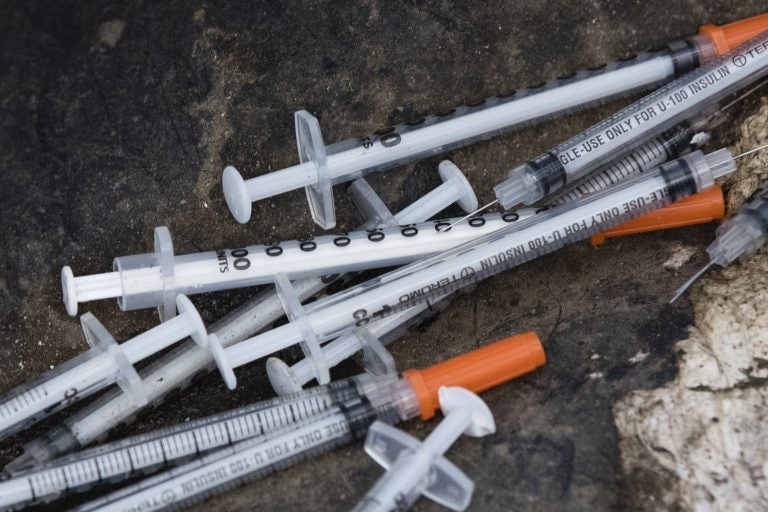
Discarded syringes lay near near train tracks in Philadelphia, Monday, July 31, 2017. (AP Photo/Matt Rourke)
From Philly and the Pa. suburbs to South Jersey and Delaware, what would you like WHYY News to cover? Let us know!
Philadelphia is seeing a slight drop in drug overdose deaths for the first time in five years, new data shows, but novel substances are gradually overtaking the street drug supply, putting people who use drugs at risk of new health complications.
The city Department of Public Health released final data for 2023 just this week, which showed that there were 1,310 drug overdose deaths that year.
It’s a 7% decrease from the year before, which has experts optimistic, but the figure is still the second-highest number of overdose deaths on record.
“But we also know this is not a time to celebrate. We know that every single life that is lost to overdose is preventable,” said Keli McLoyd, director of the city’s Opioid Response Unit. “We are going to keep our foot on the gas to make even more inroads with respect to preventing overdoses.”
Public health leaders credited the decline to more aggressive addiction prevention and treatment efforts in recent years. That has included widespread distribution and access to naloxone, an opioid overdose reversal medication, and the availability of medications to treat opioid use disorders like buprenorphine.
Experts also pointed to rapid changes in Philly’s street drug supply. While fentanyl remains a leading culprit in overdose deaths, street drugs are more often being mixed with stimulants like cocaine, which were present in more than half of all 2023 opioid overdose deaths.
Street drugs are also being cut or diluted with other adulterants, or substances used to bulk up the supply or enhance the effects of the illegal drugs they’re combined with.
Dr. Daniel Teixeira da Silva, medical director of substance use prevention and harm reduction at the Philadelphia Department of Public Health, said the veterinary sedative xylazine, an adulterant known as “tranq,” continues to cause painful and sometimes life-threatening injuries.
“In 2023, we saw the highest burden of skin wounds among people who use drugs in Philadelphia since 2010,” da Silva said.
Now, medetomidine, another even more potent veterinary sedative, is emerging and overtaking xylazine in street dope samples, newer research shows. The adulterant comes with its own signature health effects, including heart complications and nervous system disorders.
“Within three or four hours in the emergency department, they suddenly get a lot sicker. Their blood pressure spikes, their heart rate spikes, they get these kind of shakes,” said Dr. Jeanmarie Perrone, an emergency and addiction medicine physician at the University of Pennsylvania. “And they’re like, ‘This is what I mean, doc, this is what’s happening to me.’ You hear that and you see them, you’re like, ‘This does not look like really anything else that I’ve seen.’”
The rise of medetomidine: ‘Greater than anything we ever saw’
Despite a slight overall decline in drug overdose deaths, xylazine was present in 38% of all fatal cases in 2023. That’s a 3% increase from the year before, city data shows.
Just as city public health officials, hospitals, harm reduction groups and treatment programs begin to grasp the complications of tranq and adjust care and treatment protocols, medetomidine is gaining ground.
The substance was detected in 72% of illegal opioid drug samples tested in Philadelphia from September through December of last year, according to a new study published Thursday in the Centers for Disease Control and Prevention’s Morbidity and Mortality Weekly Report.
Clinicians and researchers at UPenn, Thomas Jefferson University and Temple University used electronic medical records to identify possible medetomidine withdrawal syndromes in patients who were also using fentanyl.
Among the 165 patients, 150 of them required the intensive care unit to help manage and treat medetomidine withdrawal — a big departure from what clinicians typically see with other common street drugs, Perrone said.
“Fentanyl alone, most patients would respond to naloxone. They might be discharged from the emergency department,” she said. “These patients were not just admitted to the hospital, but the majority were admitted to ICUs for days and days. So it’s really a very different clinical impact that’s much greater than anything we ever saw with xylazine or any other adulterant in the past.”
Researchers think a medication called dexmedetomidine could be used to successfully address withdrawal symptoms from street medetomidine. The clinical medication is a sedative commonly used in ICUs for intubated patients.
“As we know that that’s kind of an antidote, for now, we will probably adapt some of our procedures to be able to give the medication earlier like in the emergency department and maybe even in another form so that patients can stabilize and maybe not need the ICU,” Perrone said.
Perrone said data and information like this could be crucial to not only health providers in Philly, but in other cities and communities grappling with medetomidine in their local drug supply.
Whether or not medetomidine will take off like xylazine or disappear from the supply just as quickly as it arrived, nobody knows for sure.
“Is this just a blip, or are we going to see xylazine and medetomidine together?” Perrone wondered. “We wanted to put out our best summary of what was happening so that we could be a resource to other places as this creeps out of our area — if it does. We wanted to be prepared in that way.”
Addressing racial disparities and establishing real-time drug checking data
The Philadelphia report showing the positive trend of fewer overdoses is not being seen everywhere, and racial disparities remain.
While there was a 15% decrease in overdose deaths among white residents, there was a smaller decline of 5% among Black residents, and a 2% increase in deaths among Hispanic people.
McLoyd said the city is planning to expand its door-to-door canvassing program, which distributes free naloxone and information about addiction prevention and treatment. There will be a specific focus on reaching Spanish speakers and recruiting community members to become trusted messengers.
The city also has plans to expand its drug checking programs and surveillance, which monitor the changes of substances currently circulating in street supplies.
“And that can change from one use episode to the next use episode, from day to day,” da Silva said. “People who use dope right now really don’t know what they’re using.”
He hopes expanded surveillance can one day provide more real-time data to health care providers, community organizations and people who use drugs.

Get daily updates from WHYY News!
WHYY is your source for fact-based, in-depth journalism and information. As a nonprofit organization, we rely on financial support from readers like you. Please give today.


